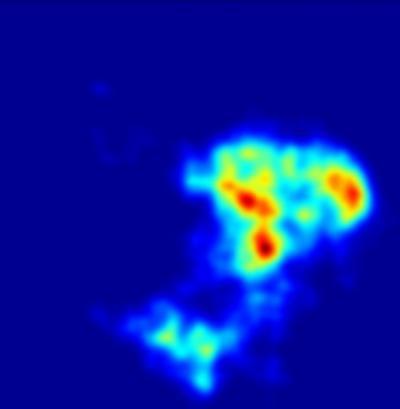Anesthesia works, we know that. Properly done, patients can be temporarily rendered completely unresponsive during surgery and then wake up again, with their memories and skills intact. Improperly done, of course, can be very bad.
But little is understood about the processes used by structurally normal brains to navigate from unconsciousness back to consciousness. Anesthesia leads the world in retracted papers.
Previous research has shown that the anesthetized brain is not "silent" under surgical levels of anesthesia but experiences certain patterns of activity, and it spontaneously changes its activity patterns over time.

New findings suggest the anesthetized brain must pass through certain "hubs" on the path back to consciousness. Above, the prevalence of particular clusters of brain activity states as recorded in rats that had been administered an anesthetic. The longest appear in red and the shortest in yellow and green. Credit: UCLA
For a new paper in
the Proceedings of the National Academy of Sciences, a research team recorded the electrical activity from several brain areas associated with arousal and consciousness in a rodent model that had been given the inhaled anesthetic isoflurane. They then slowly decreased the amount of anesthesia, as is done with patients in the operating room, monitoring how the electrical activity in the brain changed and looking for common activity patterns across all the study subjects.
The researchers found that the brain activity occurred in discrete clumps, or clusters, and that the brain did not jump between all of the clusters uniformly.
A small number of activity patterns consistently occurred in the anesthetized rodents, Hudson noted. The patterns depended on how much anesthesia the subject was receiving, and the brain would jump spontaneously from one activity pattern to another. A few activity patterns served as "hubs" on the way back to consciousness, connecting activity patterns consistent with deeper anesthesia to those observed under lighter anesthesia.
"Recovery from anesthesia is not simply the result of the anesthetic 'wearing off,' but also of the brain finding its way back through a maze of possible activity states to those that allow conscious experience," says Dr. Andrew Hudson, an assistant professor in anesthesiology at the David Geffen School of Medicine at UCLA. "Put simply, the brain reboots itself."
The study suggests a new way to think about the human brain under anesthesia, and could encourage physicians to reexamine how they approach monitoring anesthesia in the operating room. Additionally, if the results are applicable to other disorders of consciousness — such as coma or minimally conscious states — doctors may be better able to predict functional recovery from brain injuries by looking at the spontaneously occurring jumps in brain activity.
In addition, this work provides some constraints for theories about how the brain leads to consciousness itself, Hudson said.
Going forward, the UCLA researchers will test other anesthetic agents to determine if they produce similar characteristic brain activity patterns with "hub" states. They also hope to better characterize how the brain jumps between patterns.





Comments